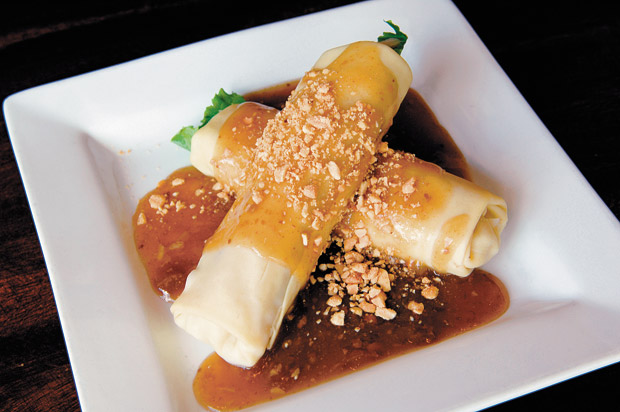
Amid a flourishing grove of palm trees, the editor shows off fresh stocks of heart of palm.
Though we’re constantly surrounded by endless stretches of palm trees swaying in the breeze of our island home, we don’t usually associate them with our diets beyond the oh-so-classic coconut. But palm trees also give us fresh, healthy stocks of heart of palm, which often are found chopped up in refreshing summer salads.
How do those crispy white chunks come from a palm tree, you may ask? I found myself wondering the same thing this week, so I set out to find the answer.
Its appearance on a plate is much different than its origin, but heart of palm is, in fact, exactly what it sounds like: The vegetable comes from the inner core of the trunks of various palm tree varieties, including coconut trees. Once the outer rim of the stems, especially in young or still-growing trees, are removed — think peeling away the layers of an onion — a soft, juicy palm heart is revealed within, sparkling like a hidden treasure trove of protein, fiber, potassium, vitamin C and other healthy benefits.
This somewhat mysterious veggie is grown sustainably in the Islands at farms such as Puna Gardens on the Big Island, for use in fine-dining restaurants both locally and afar.
Through my tasty research, I discovered that heart of palm is great for enjoying in much more than just salads. It has a slightly sweet flavor and artichoke heart-like quality, and it may be mild, but it is by no means bland when combined with a wide range of flavors.
‘COCONUTS’ ABOUT HEART OF PALM
Filipino food is known for its abundant use of coconuts, with coconut milk, for example, making its way into both sweet and savory recipes. At Max’s of Manila, Hawaii’s haven of Filipino cuisine, coconut trees are also the source of the main ingredient in Lumpiang Ubod, or Heart of Palm Roll.
Priced at $7.50 for two pieces, the appetizer gets its signature filling from a mix of shredded hearts of palm seasoned with crab meat and shrimp. The roll can be served in two mouthwatering ways: With fresh, crepe-like wrappers, which general manager Maly San Luis calls the most popular option, or with a golden, fried egg roll wrapper. The fresh rolls are enhanced with warm soy, garlic and peanut sauce, while the fried rolls come with a yummy dousing of garlic vinegar sauce.

Fresh Lumpiang Ubod, or Heart of Palm Roll, from Max’s ($7.50). L. TABUDLO PHOTO
In addition to the pupu serving, Lumpiang Ubod may be ordered in party platters as well. Mini Lumpiang Ubod Platter ($98.50) presents 40 smaller sized rolls (fresh or fried), while Lumpia Combo Platter ($89.75) includes 80 pieces of Lumpiang Shanghai egg rolls and 20 pieces of mini Lumpiang Ubod rolls. Max’s also makes a heart of palm salad party platter priced at $59.95, which is available when ordered in advance, and lights up with pineapple and raisins in a creamy dressing.
San Luis adds that patrons should look out for a slew of exciting upcoming specials at Max’s of Manila, which originated in the Philippines seven decades ago. In September, the restaurant will launch a new dish, Sizzling Bangus (Boneless Milk Fish) Tofu Steak ($13.75), and on Oct. 18, the establishment’s annual anniversary special offers 50 percent off Max’s famous Fried Chicken.
Max’s of Manila
Costco Iwilei Complex,
801 Dillingham Blvd. (and in Waipahu)
599-5033
Honolulu, HI 96817
WE HEART THIS VEGGIE
Odori-ko’s roots are in tried-and-true Japanese dining, which the Takei family has been serving since they first opened shop in Waikiki in the ’70s. But since relocating to Kapiolani Boulevard last year, the family-run restaurant has added a slew of modern twists to its traditional menu, including Palm Heart Tempura ($7.50).
The fresh pieces of subtly sweet hearts of palm are fried in a light tempura batter to the point of being drool-worthy. Salt is served on the side to bring out the natural flavor of the vegetable.

Odori-ko’s Palm Heart Tempura ($7.50) is sure to please. PHOTO COURTESY OF ODORI-KO
“Most people like the tempura with salt, but I love it with traditional tempura sauce for dipping — broke da mouth ono, just melts in my mouth!” says the restaurant’s PR and marketing director Mona Wood-Sword.
This new twist on classic tempura is made with locally sourced heart of palm from the Big Island, and Wood-Sword points to the wealth of vitamins and minerals in the vegetable, such as magnesium, zinc, folate and other benefits.
Most importantly, the flavors are spot on. “The combo of palm hearts and Odori-ko’s special light tempura batter are just a marriage made in heaven — I’m totally addicted,” concurs Wood-Sword. “I never had hearts of palm until I started working with Odoriko. The taste is light, slightly crunchy, with a perfect consistency for tempura — a little bit like zucchini, but I think it’s even better.”
Complement this appetizer with the eatery’s melange of Japanese and local-inspired fare, specialty cocktails, bentos and take-out-friendly options served during lunch, and live entertainment.
Odori-ko
1680 Kapiolani Blvd., Honolulu
955-6555
Honolulu, HI 96814
See more articles from: Max's of Manila, Odori-Ko

